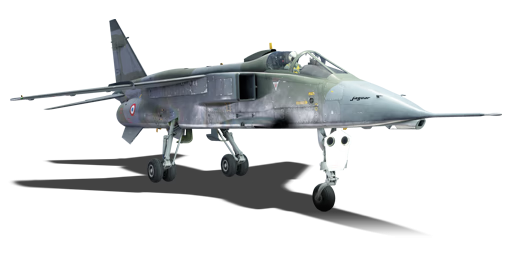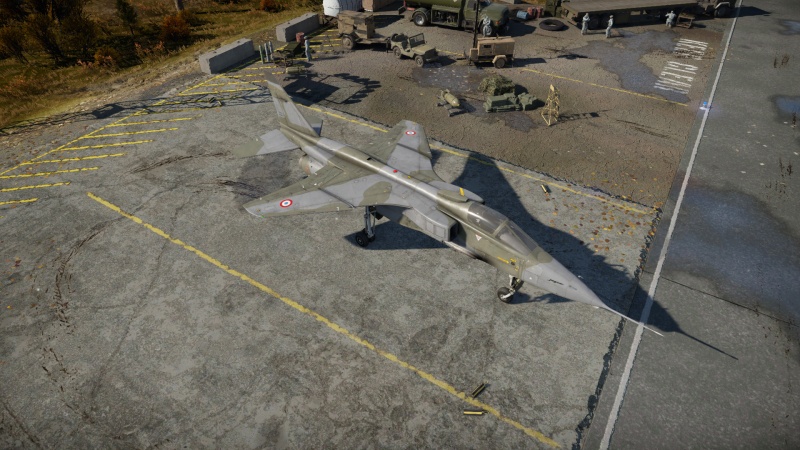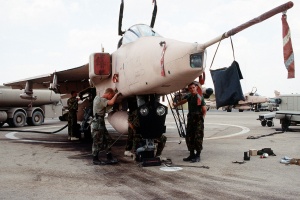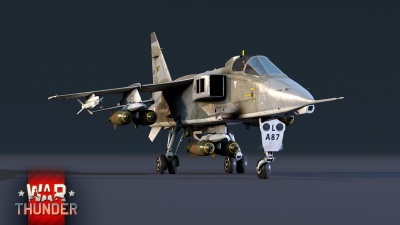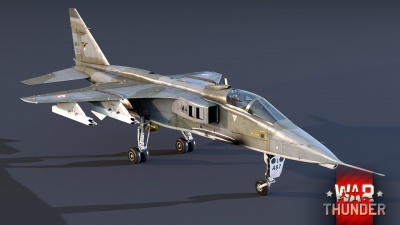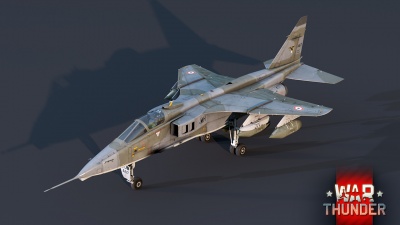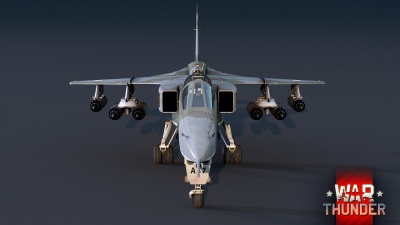Difference between revisions of "Jaguar A"
superski01 (talk | contribs) m (→Usage in battles) (Tag: Visual edit) |
(→Pros and cons) |
||
| Line 178: | Line 178: | ||
* Small frame, hard to hit with guns | * Small frame, hard to hit with guns | ||
* Nimble and agile while not loaded | * Nimble and agile while not loaded | ||
| − | * Carries two extremely efficient Matra R550 Magic missiles | + | * Carries two extremely efficient [[Matra R550 Magic 1]] missiles |
* Carries an exotic weapon for CAS, which players are not used to face | * Carries an exotic weapon for CAS, which players are not used to face | ||
* Can be played as a bomb truck | * Can be played as a bomb truck | ||
| − | * Has a [[HUD#410SUM1|Head-Up Display]] in the cockpit which provides flight information and weapon aiming functionality | + | * Has a [[HUD#410SUM1|Head-Up Display]] in the cockpit which provides flight information and weapon aiming functionality |
| − | * Very effective [[TBA Multi-Dart 100 AB | + | * Very effective [[TBA Multi-Dart 100 AB]] rockets containing an array of six sub-calibre darts, each a small kinetic penetrator capable of piercing 80 mm of armour |
'''Cons:''' | '''Cons:''' | ||
Revision as of 07:28, 20 August 2021
| This page is about the French strike aircraft Jaguar A. For the British version, see Jaguar GR.1. |
Contents
Description
The Jaguar A is a rank VII French strike aircraft with a battle rating of 10.7 (AB/RB) and 10.3 (SB). It was introduced in Update "Raining Fire". It is a twin-engine ground assault aircraft, designed with the transport and operation of heavy ordnance in mind. It also comes equipped with air-to-air missiles, in the form of the dreaded Matra R550 Magic 1. Overall a bomb truck, it is very unwieldy while fully loaded, but is exceptionally nimble once its bomb/rocket load is expended.
General info
Flight performance
The SEPECAT Jaguar is a relatively small aircraft, with a relatively small wing surface area, yet it boasts two jet engines, each yielding nearly two tons of wet thrust. These characteristics give the Jaguar exceptional agility and responsiveness, being able to engage turnfights if necessary. On the other hand, this small frame makes the Jaguar turn into a brick when loaded with bombs, even becoming so heavy it becomes very hard to take-off. The wings are of a swept design, and the Jaguar loses energy while turning only moderately, not being a BnZ fighter, but not being as bad as a Mirage IIIC or a J35D Draken. Overall it is a quite average fighter, while not loaded.
| Characteristics | Max Speed (km/h at 10,668 m) |
Max altitude (metres) |
Turn time (seconds) |
Rate of climb (metres/second) |
Take-off run (metres) | |||
|---|---|---|---|---|---|---|---|---|
| AB | RB | AB | RB | AB | RB | |||
| Stock | 1,657 | 1,645 | 13716 | 31.8 | 32.4 | 74.2 | 66.2 | 850 |
| Upgraded | 1,728 | 1,688 | 28.5 | 30.0 | 109.3 | 90.0 | ||
Details
| Features | |||||
|---|---|---|---|---|---|
| Combat flaps | Take-off flaps | Landing flaps | Air brakes | Arrestor gear | Drogue chute |
| ✓ | ✓ | ✓ | ✓ | ✓ | ✓ |
| Limits | ||||||
|---|---|---|---|---|---|---|
| Wings (km/h) | Gear (km/h) | Flaps (km/h) | Max Static G | |||
| Combat | Take-off | Landing | + | - | ||
| 0 | 481 | 926 | 525 | 410 | ~12 | ~6 |
| Optimal velocities (km/h) | |||
|---|---|---|---|
| Ailerons | Rudder | Elevators | Radiator |
| < 650 | < 600 | < 720 | N/A |
Engine performance
| Engine | Aircraft mass | |||||||
|---|---|---|---|---|---|---|---|---|
| Engine name | Number | Basic mass | Wing loading (full fuel) | |||||
| Rolls-Royce Turbomeca Limited Adour Mk.102 | 2 | 7,616 kg | 453 kg/m2 | |||||
| Engine characteristics | Mass with fuel (no weapons load) | Max Takeoff Weight | ||||||
| Weight (each) | Type | 15m fuel | 20m fuel | 30m fuel | 45m fuel | 53m fuel | ||
| 709 kg | Afterburning low-bypass turbofan | 8,592 kg | 8,838 kg | 9,449 kg | 10,365 kg | 10,869 kg | 13,500 kg | |
| Maximum engine thrust @ 0 m (RB/SB) | Thrust to weight ratio @ 0 m (WEP) | |||||||
| Condition | 100% | WEP | 15m fuel | 20m fuel | 30m fuel | 45m fuel | 53m fuel | MTOW |
| Stationary | 1,998 kgf | 3,094 kgf | 0.72 | 0.70 | 0.65 | 0.60 | 0.57 | 0.46 |
| Optimal | 2,242 kgf (200 km/h) |
3,307 kgf (200 km/h) |
0.77 | 0.75 | 0.70 | 0.64 | 0.61 | 0.49 |
Survivability and armour
The Jaguar A has no armour plating or armoured glass. The entire wings of the Jaguar A are made up of fuel tanks, along with most of the upper fuselage, with flight controls being exposed in the "spine" of the aircraft. The two engines take up a small amount of room in the very rear of the fuselage.
Modifications and economy
Armaments
| Ballistic Computer | |||
|---|---|---|---|
| CCIP (Guns) | CCIP (Rockets) | CCIP (Bombs) | CCRP (Bombs) |
| |
|
|
|
Offensive armament
The Jaguar A is armed with:
- 2 x 30 mm DEFA 553 cannons, belly-mounted (150 rpg = 300 total)
Suspended armament
The Jaguar A can be outfitted with the following ordnance:
- Without load
- 11 x 250 kg SAMP Type 25 bombs (2,750 kg total)
- 8 x 400 kg SAMP Type 21 bombs (3,200 kg total)
- 108 x SNEB type 23 rockets
- 144 x SNEB type 23 rockets
- 16 x TBA ECC rockets
- 16 x TBA Multi-Dart 100 AB rockets
- 2 x Matra R550 Magic 1 missiles
- 2 x Matra R550 Magic 1 missiles + 9 x 250 kg SAMP Type 25 bombs (2,250 kg total)
- 2 x Matra R550 Magic 1 missiles + 6 x 400 kg SAMP Type 21 bombs (2,400 kg total)
- 2 x Matra R550 Magic 1 missiles + 72 x SNEB type 23 rockets
- 2 x Matra R550 Magic 1 missiles + 72 x SNEB type 23 rockets
- 2 x Matra R550 Magic 1 missiles + 8 x TBA ECC rockets
- 2 x Matra R550 Magic 1 missiles + 8 x TBA Multi-Dart 100 AB rockets
The sets of bombs are the heaviest ordnances for the aircraft, but ensure a good supply of CAS support capability, even though bomb runs in combined battles are extremely dangerous at such BRs.
The most exotic loadout proposed by the Jaguar A is the TBA Multi-Dart 100 AB rocket. This rocket is a hypersonic, sub-munition-carrying vessel, with each rocket carrying six darts, and reaching 1400 m/s, or Mach 4.2. Each dart is in fact a small kinetic penetrator, each being able to penetrate 80 mm of flat armour, and relying only on fragmentation of armour as post-penetration damage. While these darts cannot pierce the front (or even side) hull of a modern MBT, it will pierce its roof without problems, and the rocket speed and number of darts gives the possibility of top attacks from a safe distance, with extreme precision.
Usage in battles
The Jaguar A is a catastrophic aircraft to grind, because its only air-to-air missiles are locked as a rank 4 modification. The entirety of its opposition will be carrying both IR and semi-active radar missiles. Once these missiles are researched, the Jaguar becomes a force to be reckoned with, and it can be expected that a few kills can be made on unsuspecting enemies. The bomb/rocket load of the Jaguar A is decent, and bombing bases and key targets is definitely a good way to acquire experience. Carrying a hybrid air-to-air and air-to-ground load is a good compromise, retaining adequate ground pounding capabilities while acquiring self-defence capabilities.
It is a good tactic to let pure fighters go in front, and remain at low altitude. That way the Jaguar will not be in the front lines, and will be able to expend its bomb load and attempt to help fighters with its missiles. The Jaguar cannot face aircraft such as a MiG-21, or a Mirage IIIC, or even a Phantom II and be expected to win. The aircraft fares better as a support aircraft.
In Combined battles, many CAS options are available. Be it the SAMP bombs, SNEB rockets, or Multi-Dart rockets, with the latter being its cutting edge weapon against ground forces. Remaining at a safe distance and avoiding incoming missiles while selecting a target, then pointing it swiftly for a top attack with one or more Multi-Dart rockets seems to be an adequate usage of these weapons. It can be decided to abandon the air-to-air missiles to carry more ordnance, that is a choice of attack paradigm each player must make.
Pros and cons
Pros:
- Small frame, hard to hit with guns
- Nimble and agile while not loaded
- Carries two extremely efficient Matra R550 Magic 1 missiles
- Carries an exotic weapon for CAS, which players are not used to face
- Can be played as a bomb truck
- Has a Head-Up Display in the cockpit which provides flight information and weapon aiming functionality
- Very effective TBA Multi-Dart 100 AB rockets containing an array of six sub-calibre darts, each a small kinetic penetrator capable of piercing 80 mm of armour
Cons:
- Mediocre speed performance
- Researching the modifications are a hassle
- Basically a barely flying anvil when fully loaded with bombs
- Does not carry flares
- No protection
- No radar (and thus no radar guided missiles)
History
The Jaguar A was the French variant of the SEPECAT Jaguar developed jointly by France and the United Kingdom. The first prototype flew in late 1968, fitted with the Adour engine. The aircraft later flew at the Paris Air Show in 1969, and the further developed Jaguar A prototype, improved and designed for French service, flew in March of that year. After the commencement of production, the French Air Service accepted the first Jaguar A in December of 1973, one of an eventual 160 Jaguar A aircraft that would serve with the Air Service. As well, the Air Ministry procured 40 additional Jaguar E trainers, to help train pilots for the Jaguar A.
The aircraft was able to carry an AN-52 nuclear bomb; however, the aircraft never served with the French strategic nuclear force as the role had been taken by the Mirage IV. The aircraft was immediately pressed into service defending national interests in Africa, a mission sometimes referred to as "Jaguar Diplomacy". Thus, Jaguars had their combat debut fighting rebels in Mauritania. The aircraft also flew in the Chad-Libya conflict and in the Central African Republic. During its time in African-theatre service, the Jaguar gained a reputation for being a highly effective ground attacker; Libyan forces frequently tried to sabotage the Jaguars stationed in Chad due to their effectiveness against ground targets.
Later on, Jaguars served in the Gulf War and the 1999 Kosovo conflict. The aircraft flew 615 sorties in the Gulf War, and one aircraft was lost to an Iraqi SAM. The plane was frequently used to destroy Iraqi convoys, naval vessels and Scud missile sites. The aircraft also performed a valuable reconnaissance role, providing aerial photography and intelligence for the NATO forces. The Jaguars went on to serve until 2005 when they were replaced in the ground-attack role by the Dassault Rafale.
Devblog
In the early 1960's, both Great Britain and France were looking into procuring a new jet trainer for their respective air forces. Despite differences in specifications and requirements, the two nations were united in their pursuit for such a new aircraft, thus leading to an agreement being signed in 1965 which would kick off development of what would eventually become the Jaguar.
The Jaguar was being developed under a specially formed consortium of British and French aviation companies, namely Bréguet and BAC, called SEPECAT (you can look up what the acronym stands for on your own - we promise you won't be disappointed though). Continuing with the theme of joint projects, Rolls-Royce and Turbomeca also joined forces to develop a new turbofan engine - the Adour - for the new aircraft.
The first of eight prototypes of the Jaguar successfully conducted its maiden flight in September of 1968. Following the conclusion of further testing, the Jaguar went into production in two major variants - the Jaguar A being the modification used by the French Air Force and the Jaguar S (Jaguar GR.1) being the variant employed by the RAF. Both variants of the machine entered production in the early 1970's, with the first production models being delivered in 1973/'74.
The Jaguar primarily served with France and Great Britain, most notably distinguishing itself in action during the Gulf War of the 1990's. However, Ecuador, Nigeria and Oman also operated modifications of the Jaguar, while India still operates the Jaguar to this day. In total over 540 SEPECAT Jaguars were built.
Media
- Skins
- Images
- Jaguar A Devblog Images
- Videos
See also
External links
| SEPECAT | |
|---|---|
| Jet fighters | Jaguar A · Jaguar E · Jaguar GR.1 · Jaguar GR.1A · Jaguar IS* |
| SEPECAT was a joint venture between BAC (later BAe) and Bréguet (later merged with Dassault). Production were split between the two manufacturers. *Built by BAe and Hindustan Aeronautics Limited (HAL). | |
| France jet aircraft | |
|---|---|
| Fighters | M.D.450B Ouragan · M.D.450B Barougan · M.D.452 IIA · M.D.452 IIC · Mystere IVA · Super Mystere B2 |
| ▄F-86K · ▄F-100D · ▄F-8E(FN) | |
| Mirage IIIC · Mirage IIIE · Milan · Mirage 5F · Mirage 2000C-S4 · Mirage 2000C-S5 · Mirage 2000-5F · Mirage 4000 | |
| Mirage F1C · Mirage F1C-200 · Mirage F1CT | |
| Strike aircraft | ▄F-84F · F-84F IAF · ▄F-84G-26-RE |
| Etendard IVM · Super Etendard · Alpha Jet E | |
| Jaguar A · Jaguar E · Mirage 2000D-R1 · Mirage 2000D-RMV | |
| Bombers | S.O.4050 Vautour IIA · Vautour IIA IDF/AF · S.O.4050 Vautour IIB · S.O.4050 Vautour IIN · S.O.4050 Vautour IIN (late) |
| Belgium | ▄Meteor F Mk.8 · ▄Mirage 5BA · ▄F-104G · ▄F-16A · ▄F-16AM |
| Netherlands | ◘Sea Hawk Mk.50 · ◘Hunter F.6 |


